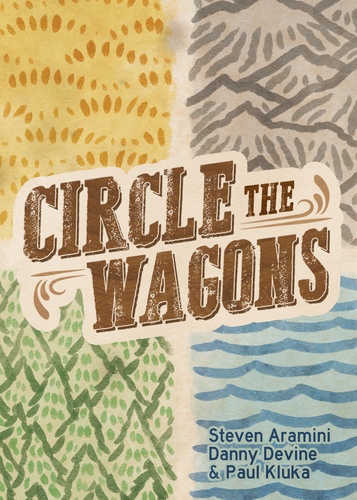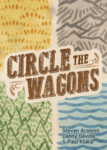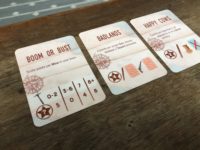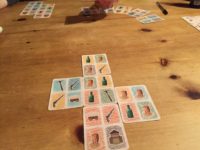- Learning time
- 10 minutes
- First play time
- 15 minutes
Circle the Wagons
Designed by: Danny Devine,Paul Kluka,Steven Aramini
Circle the Wagons is a two-player card game where both players are building a boom town in the old west.
The deck is made up of 18 cards which are quartered into four territories on the front (rivers, mountains, forests, etc) and different rules for scoring on the back. Three cards are flipped randomly (or chosen, if you prefer) to decide what the scoring rules are for the game – and each card has a unique way of scoring: it might be points for cattle or mines, or not having certain territory types adjacent, or a number of different things.
The remaining fifteen cards are laid in a circle on the table. Each player will be building by laying these cards in front of them in a growing landscape representing your boom town – cards can lie adjacent or overlap, but they must connect in some way and cannot be placed sideways!
Play moves clockwise around the circle from an agreed starting point. When it’s your turn, you can choose to take the next available card – or jump forward to another. The catch is, every card you skip past goes to your opponent. When all cards are taken, the game finishes and scores are totalled. Not only do you score points for the categories on the three scoring cards, but also for the largest of each type of territory you have.
The guru's verdict

-
Take That!
Take That!
Players can jump ahead to grab a juicy card, but as the opponent is hoovering up everything they skipped past, it's nothing to get too hot under the collar about.
-
Fidget Factor!
Fidget Factor!
Minimal
-
Brain Burn!
Brain Burn!
Sometimes there's a decision to be made between scoring big areas and going for the bespoke rules for a particular game. But mainly it's about watching what your opponent has, and needs.
-
Again Again!
Again Again!
The 18 different bespoke rules played three at a time means there's a huge amount of variety in how you score.














Sam says
Pretty artwork, clever game-play and a neat way of giving lots of variety to scoring. With micro-games the aim is usually a portable, lightly-engaging diversion you can play almost anywhere. And as such Circle the Wagons certainly ticks those boxes, with some élan.